D-Link 150 User Manual
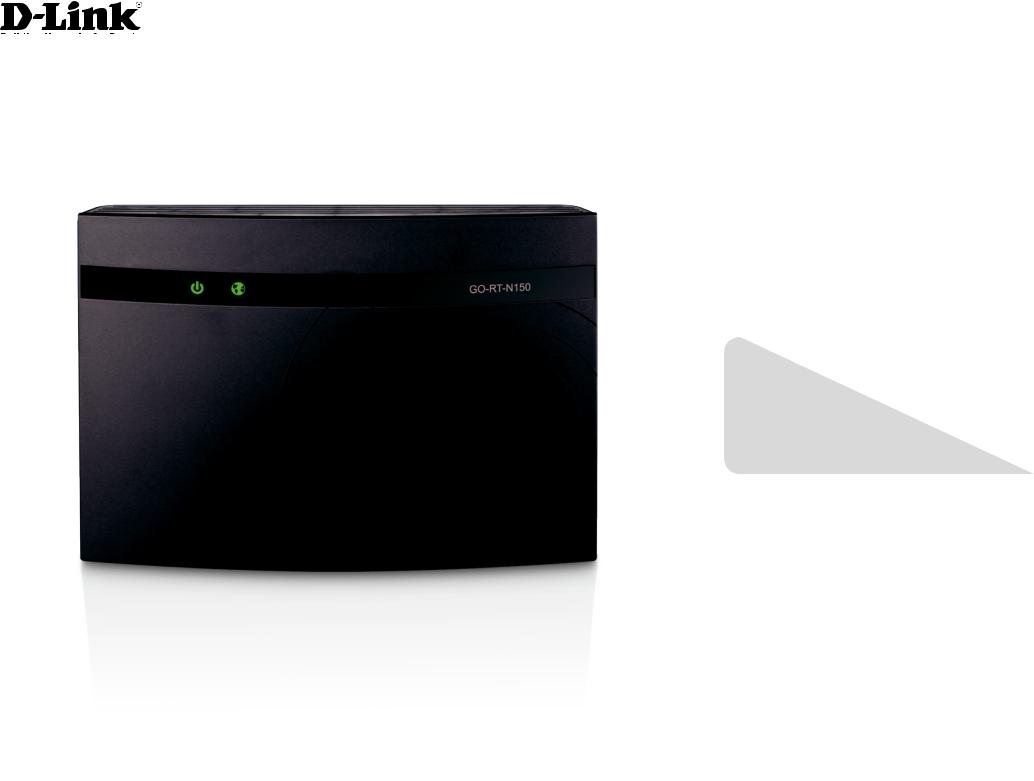
Version 1.0 | 03/08/2013
User Manual
Wireless N 150 Easy Router

Preface
D-Link reserves the right to revise this publication and to make changes in the content hereof without obligation to notify any person or organization of such revisions or changes.
Manual Revisions
Revision |
Date |
Description |
1.0March 08, 2013 • Second release version
Trademarks
D-Link and the D-Link logo are trademarks or registered trademarks of D-Link Corporation or its subsidiaries in the United States or other countries. All other company or product names mentioned herein are trademarks or registered trademarks of their respective companies.
Copyright © 2013 by D-Link Systems, Inc.
All rights reserved. This publication may not be reproduced, in whole or in part, without prior expressed written permission from D-Link Systems, Inc.
D-Link GO-RT-N150 User Manual |
i |

Table of Contents
Table of Contents
Preface........................................................................................... |
i |
Manual Revisions........................................................................... |
i |
Trademarks....................................................................................... |
i |
Product Overview...................................................................... |
1 |
Package Contents......................................................................... |
1 |
System Requirements.................................................................. |
2 |
Features............................................................................................ |
3 |
Hardware Overview...................................................................... |
4 |
Connections............................................................................ |
4 |
LEDs............................................................................................ |
5 |
Installation................................................................................... |
6 |
Before you Begin........................................................................... |
6 |
Wireless Installation Considerations...................................... |
7 |
Connect to Cable/DSL/Satellite Modem............................... |
8 |
Connect to Another Router....................................................... |
9 |
Configuration........................................................................... |
11 |
Setup............................................................................................... |
11 |
Easy Setup Wizard............................................................... |
12 |
Internet Configuration...................................................... |
15 |
Dynamic (Cable).............................................................. |
15 |
Dynamic IP Address (DHCP)....................................... |
16 |
PPPoE (DSL)...................................................................... |
17 |
Static IP Address.............................................................. |
19 |
Wireless Settings.................................................................. |
20 |
Manual Wireless Network Setup............................... |
21 |
Network Settings................................................................. |
23 |
DHCP Server Settings.................................................... |
24 |
DHCP Reservation.......................................................... |
25 |
Advanced....................................................................................... |
26 |
Virtual Server........................................................................ |
26 |
Port Forwarding................................................................... |
28 |
Application Rules................................................................ |
29 |
Traffic Control....................................................................... |
30 |
Network Filters..................................................................... |
31 |
Website Filters...................................................................... |
32 |
Firewall Settings................................................................... |
33 |
Advanced Wireless Settings............................................ |
34 |
Wi-Fi Protected Setup........................................................ |
35 |
Advanced Network Settings............................................ |
37 |
Tools................................................................................................. |
38 |
Administrator Settings...................................................... |
38 |
Time Settings........................................................................ |
39 |
System Settings................................................................... |
40 |
Update Firmware................................................................. |
41 |
DDNS........................................................................................ |
42 |
Status............................................................................................... |
43 |
Device Information............................................................. |
43 |
Log............................................................................................ |
44 |
Statistics.................................................................................. |
45 |
Internet Sessions................................................................. |
46 |
Wireless................................................................................... |
47 |
Support........................................................................................... |
48 |
D-Link GO-RT-N150 User Manual |
ii |

Table of Contents |
|
Wireless Security..................................................................... |
49 |
What is WPA?................................................................................. |
49 |
Configure WPA-Personal (PSK)............................................... |
50 |
Connect to a Wireless Network............................................. |
51 |
Using Windows® 7........................................................................ |
51 |
Using Windows® XP..................................................................... |
54 |
Configure WPA-PSK............................................................ |
55 |
Troubleshooting...................................................................... |
57 |
Wireless Basics......................................................................... |
61 |
Tips................................................................................................... |
64 |
Wireless Modes............................................................................ |
65 |
Networking Basics.................................................................. |
66 |
Check your IP address................................................................ |
66 |
Statically Assign an IP address................................................ |
67 |
Technical Specifications......................................................... |
68 |
Safety Statements................................................................... |
69 |
D-Link GO-RT-N150 User Manual |
iii |

Section 1 - Product Overview
ProductPackageOverviewContents
•D-Link GO-RT-N150
•Power Adapter
•Ethernet Cable
Note: Using a power supply with a different voltage rating than the one included with the D-Link GO-RT-N150 will cause damage and void the warranty for this product.
Note: Always attach the power cord plug to the power supply before inserting the power cord and connected power supply to the wall outlet.
D-Link GO-RT-N150 User Manual |
1 |

Section 1 - Product Overview
System Requirements
Network Requirements |
• An Ethernet-based Cable or DSL modem |
• IEEE 802.11n/g wireless clients |
|
|
• 10/100 Ethernet |
|
|
|
Computer with the following: |
|
• Windows®, Macintosh, or Linux-based operating |
|
system |
|
• An installed Ethernet adapter |
|
Browser Requirements: |
Web-based Configuration |
• Internet Explorer 6.0 or higher |
• Mozilla 1.7.12 or higher |
|
Utility Requirements |
• Firefox 1.5 or higher |
|
• Safari 1.0 or higher (with Java 1.3.1 or higher) |
|
• Flock 0.7.14 or higher |
|
• Opera 6.0 or higher |
|
Windows® Users: Make sure you have the latest version of |
|
Java installed. Visit www.java.com to download the latest |
|
version. |
|
|
D-Link GO-RT-N150 User Manual |
2 |

Section 1 - Product Overview
Features
•FasterWireless Networking - The D-Link GO-RT-N150 provides up to 150Mbps* wireless connection with other 802.11n wireless clients. This capability allows users to participate in real-time activities online, such as video streaming, online gaming, and real-time audio.
•Compatible with 802.11g Devices - The D-Link GO-RT-N150 is still fully compatible with the IEEE 802.11g standard, so it can connect with existing 802.11g PCI, USB and Cardbus adapters.
•Advanced Firewall Features - The Web-based user interface displays a number of advanced network management features including:
•Content Filtering - Easily applied content filtering based on URL, and/or Domain Name.
•Secure Multiple/Concurrent Sessions - The D-Link GO-RT-N150 can pass through VPN sessions. It supports multiple and concurrent IPSec and PPTP sessions, so users behind the D-Link GO-RT-N150 can securely access corporate networks.
•Easy Setup Wizard - Through its easy-to-use Web-based user interface, the D-Link GO-RT-N150 lets you control what information is accessible to those on the wireless network, whether from the Internet or from your company’s server. Configure your router to your specific settings within minutes.
*Maximum wireless signal rate derived from IEEE Standard 802.11g and 802.11n specifications. Actual data throughput will vary. Network conditions and environmental factors, including volume of network traffic, building materials and construction, and network overhead, lower actual data throughput rate. Environmental conditions will adversely affect wireless signal range.
D-Link GO-RT-N150 User Manual |
3 |
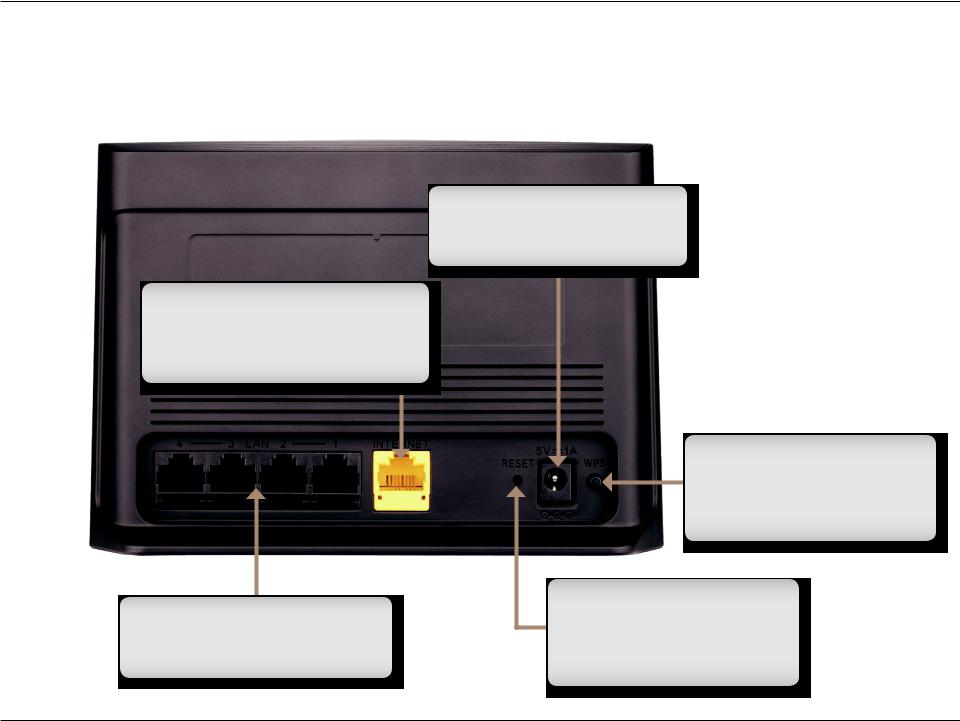
Section 1 - Product Overview
Hardware Overview
Connections
Internet Port
The auto MDI/MDIX Internet port is the connection for the Ethernet cable to the cable or DSL modem.
LAN Ports (1-4)
Connect Ethernet devices such as computers, switches, and hubs.
Power Receptor
Receptor for the supplied power adapter.
WPS Button
Pressing the WPS button allows you to establish a secure connection with a new device.
Reset
Pressing the Reset button restores the router to its original factory default settings.
D-Link GO-RT-N150 User Manual |
4 |

Section 1 - Product Overview
Hardware Overview
LEDs
Power LED
A solid light indicates a proper connection to the power supply.
Internet LED
A solid light indicates connection on the Internet port.
D-Link GO-RT-N150 User Manual |
5 |

Section 2 - Installation
Installation
This section will walk you through the installation process. Placement of the router is very important. Do not place the router in an enclosed area such as a closet or cabinet, or in the attic or garage.
Before you Begin
•Please configure the router with the computer that was last directly connected to your modem.
•You can only use the Ethernet port on your modem. If you were using the USB connection before using the router, then you must turn off your modem, disconnect the USB cable and connect an Ethernet cable to the Internet port on the router, and then turn the modem back on. In some cases, you may need to call your ISP to change the connection type from USB to Ethernet.
•If you have DSL and are connecting via PPPoE, make sure you disable or uninstall any PPPoE software such as WinPoet, Broadjump, or Enternet 300 from your computer or you will be unable to connect to the Internet.
D-Link GO-RT-N150 User Manual |
6 |

Section 2 - Installation
Wireless Installation Considerations
The D-Link wireless router lets you access your network using a wireless connection from virtually anywhere within the operating range of your wireless network. Keep in mind, however, that the number, thickness and location of walls, ceilings, or other objects that the wireless signals must pass through, may limit the range. Typical ranges vary depending on the types of materials and background RF (radio frequency) noise in your home or business. The key to maximizing wireless range is to follow these basic guidelines:
1. Keep the number of walls and ceilings between the router and other network devices to a minimum - each wall or ceiling can reduce your adapter’s range from 3-90 feet (1-30 meters.) Position your devices so that the number of walls or ceilings is minimized.
2. Be aware of the direct line between network devices. A wall that is 1.5 feet thick (.5 meters), at a 45-degree angle appears to be almost 3 feet (1 meter) thick. At a 2-degree angle it looks over 42 feet (14 meters) thick! Position devices so that the signal will travel straight through a wall or ceiling (instead of at an angle) for better reception.
3. Building materials make a difference. A solid metal door or aluminum studs may have a negative effect on range. Try to position access points, wireless routers, and computers so that the signal passes through drywall or open doorways. Materials and objects such as glass, steel, metal, walls with insulation, water (fish tanks), mirrors, file cabinets, brick, and concrete will degrade your wireless signal.
4. Keep your product away (at least 3-6 feet or 1-2 meters) from electrical devices or appliances that generate RF noise.
5. If you are using 2.4GHz cordless phones or X-10 (wireless products such as ceiling fans, lights, and home security systems), your wireless connection may degrade dramatically or drop completely. Make sure your 2.4GHz phone base is as far away from your wireless devices as possible. The base transmits a signal even if the phone is not in use.
D-Link GO-RT-N150 User Manual |
7 |

Section 2 - Installation
Connect to Cable/DSL/Satellite Modem
If you are connecting the router to a cable/DSL/satellite modem, please follow the steps below:
1.Place the router in an open and central location. Do not plug the power adapter into the router.
2.Turn the power off on your modem. If there is no on/off switch, then unplug the modem’s power adapter. Shut down your computer.
3.Unplug the Ethernet cable (that connects your computer to your modem) from your computer and plug it into the Internet port on the router.
4.Plug an Ethernet cable into one of the four LAN ports on the router. Plug the other end into the Ethernet port on your computer.
5.Turn on or plug in your modem. Wait for the modem to boot (about 30 seconds).
6.Plug the power adapter to the router and connect to an outlet or power strip. Wait about 30 seconds for the router to boot.
7.Turn on your computer.
8.Verify the link lights on the router. The power light, Internet light, and the LAN light (the port that your computer is plugged into) should be lit. If not, ensure that your computer, modem, and router are powered on, and that the cables are correctly connected.
9.Skip to page 11 to configure your router.
D-Link GO-RT-N150 User Manual |
8 |

Section 2 - Installation
Connect to Another Router
If you are connecting the D-Link router to another router to use as a wireless access point and/or switch, you will have to do the following before connecting the router to your network:
•Disable UPnP
•Disable DHCP
•Change the LAN IP address to an available address on your network. The LAN ports on the router cannot accept a DHCP address from your other router.
To connect to another router, please follow the steps below:
1.Plug the power into the router. Connect one of your computers to the router (LAN port) using an Ethernet cable. Make sure your IP address on the computer is 192.168.0.xxx (where xxx is between 2 and 254). Please see the Networking Basics section for more information. If you need to change the settings, write down your existing settings before making any changes. In most cases, your computer should be set to receive an IP address automatically in which case you will not have to do anything to your computer.
2.Open a web browser and enter http://192.168.0.1 and press Enter. When the login window appears, set the user name to Admin and leave the password box empty. Click Log In to continue.
3.Click Advanced and then click Advanced Network. Uncheck the Enable UPnP checkbox. Click Save Settings to continue.
4.Click Setup and then click Network Settings. Uncheck the Enable DHCP Server server checkbox. Click Save Settings to continue.
5.Under Router Settings, enter an available IP address and the subnet mask of your network. Click Save Settings to save your settings. Use this new IP address to access the configuration utility of the router in the future. Close the browser and change your computer’s IP settings back to the original values as in Step 1.
D-Link GO-RT-N150 User Manual |
9 |

Section 2 - Installation
6.Disconnect the Ethernet cable from the router and reconnect your computer to your network.
7.Connect an Ethernet cable to one of the LAN ports on the router and connect it to your other router. Do not plug anything into the Internet port of the D-Link router.
8.You may now use the other 3 LAN ports to connect other Ethernet devices and computers. To configure your wireless network, open a web browser and enter the IP address you assigned to the router. Refer to the Configuration and Wireless Security sections for more information on setting up your wireless network.
D-Link GO-RT-N150 User Manual |
10 |
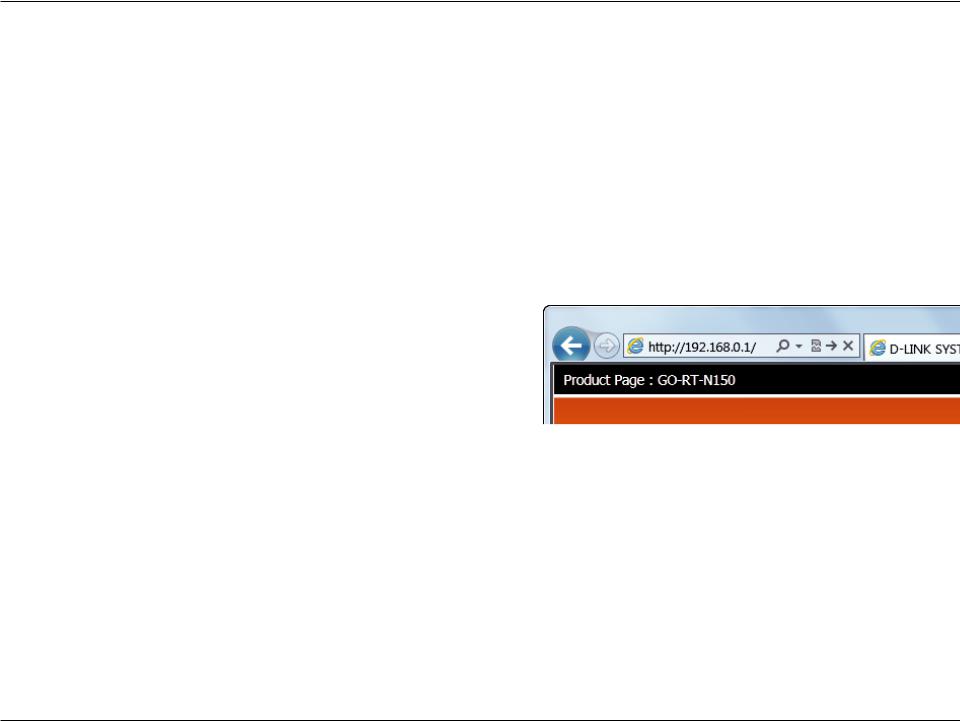
Section 3 - Configuration
Configuration
This section will show you how to configure your D-Link wireless router using the web-based configuration utility.
Setup
To access the Easy Setup Wizard or configuration utility, open a web browser such as Internet Explorer andentertheIPaddressoftherouter(http://192.168.0.1).
D-Link GO-RT-N150 User Manual |
11 |

Section 3 - Configuration
Easy Setup Wizard
Once logged into the web interface of the router, the Easy Setup Wizard will appear and perform WAN auto detection to obtain the type of Internet connection you are using.
D-Link GO-RT-N150 User Manual |
12 |
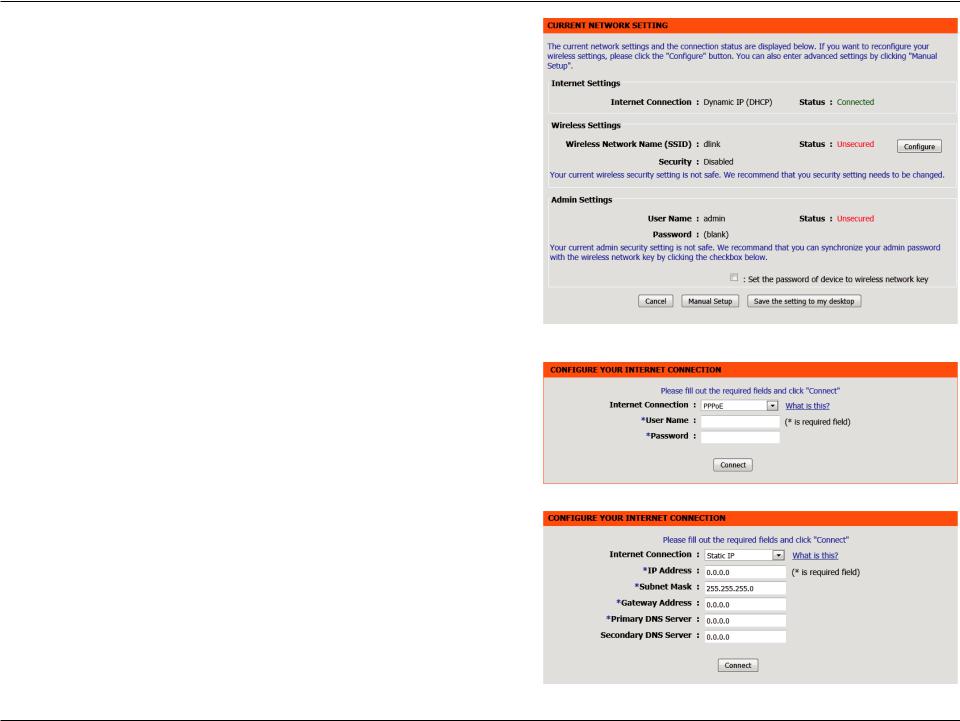
Section 3 - Configuration
According to the detection result, the wizard will indicate the type of Internet connection that you are currently using.
To configure your wireless network, click Configure in Wireless Settings. Select the type of Wireless security you use (Disable Wireless Security or AUTO-WPA/WPA2) and enter the network name (SSID, Service Set Identifier) and security password. The network name (SSID) is the name of your wireless network. Create a name using up to 32 characters.
If the type is Dynamic IP (DHCP), click Save to continue.
If the type is PPPoE, enter your PPPoE username and password. Click Next to continue.
If the type is Static IP, please enter the IP address, subnet mask, gateway, and DNS server
addresses that your ISP assigned to you. Click Connect to continue.
Note: Make sure you remove any PPPoE software from your computer. The software is no longer needed and will not work through a router.
D-Link GO-RT-N150 User Manual |
13 |
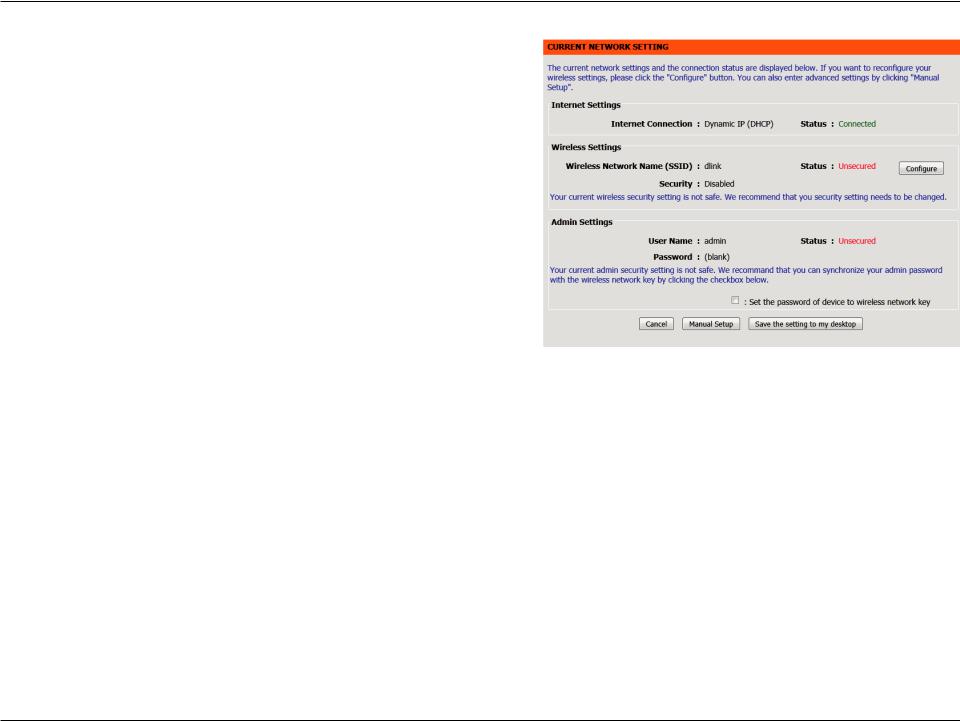
Section 3 - Configuration
In the final stage of the Easy setup wizard, the summary will show your current configuration. Click Save to complete the setup.
When the internet connectivity is established, the webpage will be redirected to the D-Link Website.
D-Link GO-RT-N150 User Manual |
14 |
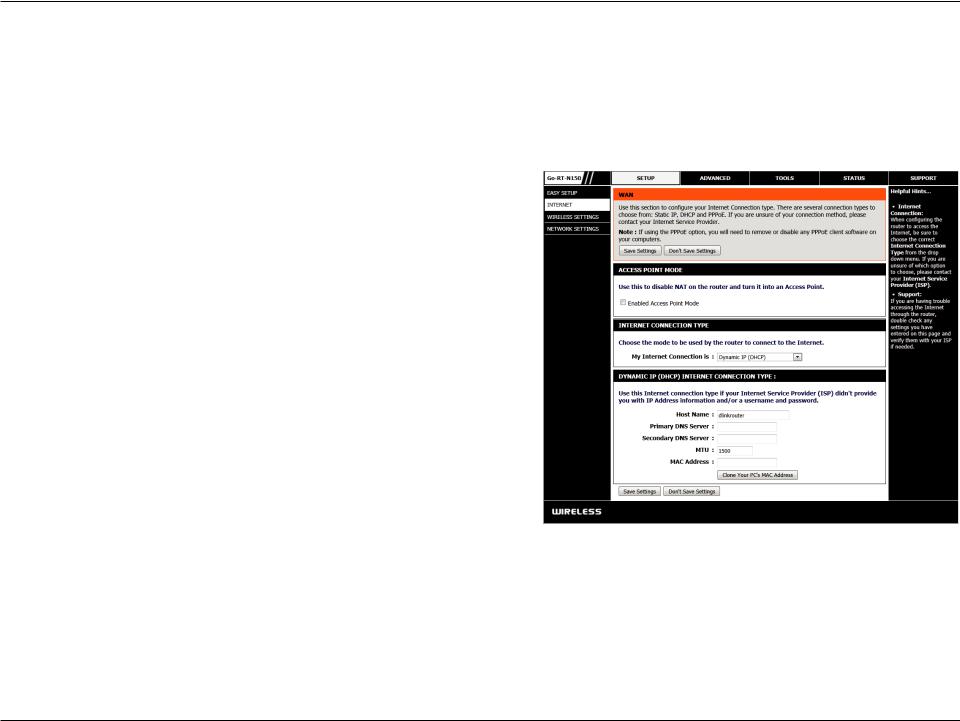
Section 3 - Configuration
Internet Configuration
Dynamic (Cable)
If you opt to set up your Internet connection manually, you will be redirected to a WAN page that allows you to select the type of your Internet connection and enter the correct configuration parameters.
Select your Internet connection type using the “My
Internet Connection is” drop-down menu.
Click Save Settings when you have configured the connection.
Access Point Use this mode to disable NAT on the router and
Mode: turn it into an Access Point
Internet
Connection Select your Internet connection type using the
Type: “Internet connection type” drop-down menu.
D-Link GO-RT-N150 User Manual |
15 |

Section 3 - Configuration
Dynamic IP Address (DHCP)
My Internet Select Dynamic IP (DHCP) to obtain IP Address
Connection: information automatically from your ISP. Select this option if your ISP did not provide you with any IP numbers to use. This option is commonly used for cable modem services.
Host Name: The Host Name is optional but may be required by some ISPs.
DNS Enter the Primary DNS server IP address assigned
Addresses: by your ISP.
MTU: Maximum Transmission Unit - you may need to change the MTU for optimal performance with your specific ISP. 1500 is the default MTU.
MAC The default MAC Address is set to the Internet Address: port’s physical interface MAC address on the router. It is not recommended that you change the default MAC address unless required by your ISP.
You can use the Clone Your PC’s MAC Address button to replace the Internet port’s MAC address with the MAC address of your Ethernet card.
D-Link GO-RT-N150 User Manual |
16 |
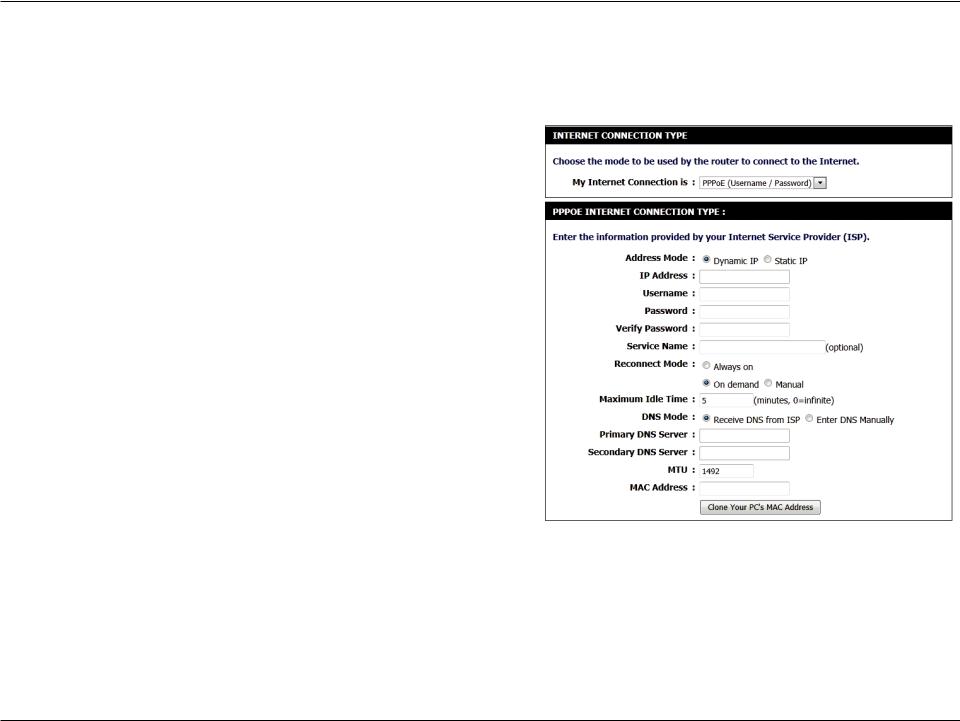
Section 3 - Configuration
PPPoE (DSL)
Choose PPPoE (Point to Point Protocol over Ethernet) if your ISP uses a PPPoE connection. Your ISP will provide you with a username and password. This option is typically used for DSL services. Make sure you remove any PPPoE software from your computer. The software is no longer needed and will not work through a router.
My Internet
Connection:
Address Mode:
IP Address:
User Name:
Password:
Service Name:
Reconnection
Mode:
Maximum Idle
Time:
DNS Addresses:
Select PPPoE (Username/Password) from the drop-down menu.
Select Static if your ISP assigned you the IP address, subnet mask, gateway, and DNS server addresses. In most cases, select Dynamic.
Enter the IP address (Static PPPoE only).
Enter your PPPoE user name.
Enter your PPPoE password and then retype the password in the next box.
Enter the ISP Service Name (optional).
Select either Always-on, On-Demand, or Manual.
Enter a maximum idle time during which the Internet connection is maintained during inactivity. To disable this feature, enable Autoreconnect.
Enter the Primary and Secondary DNS Server Addresses (Static PPPoE only).
You may need to change the Maximum
D-Link GO-RT-N150 User Manual |
17 |

Section 3 - Configuration
MTU: Transmission Unit for optimal performance with MAC Address: your specific ISP (default MTU is 1492).
The default MAC Address is set to the Internet port’s physical interface MAC address on the Broadband Router. It is not recommended that you change the default MAC address unless required by your ISP. You can use the Clone Your PC’s MAC Address button to replace the Internet port’s MAC address with the MAC address of your Ethernet card.
D-Link GO-RT-N150 User Manual |
18 |
